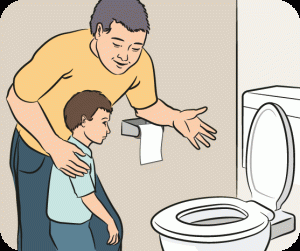BY: Aaron Verty
Uncategorized
Comments: No Comments
A Compassionate Guide to Potty Training Children on the Autism Spectrum
Potty training is a milestone for every child—but for children with autism, it can present unique challenges that call for patience, structure, and creativity. According to Autism Parenting Magazine, learning this skill may take longer due to factors like sensory sensitivities, executive functioning delays, and difficulty with transitions
1. Lay the Groundwork: Planning Is Key
Before diving in, preparation is essential. The guide recommends a three‑phase approach:
-
Planning – Gather tools like a child‑sized potty or seat attachment, footstool, timer, visual supports (charts, social stories), and incentives.
-
Setup – Adjust the bathroom for comfort and accessibility. A structured, calm environment minimizes sensory overload.
-
Implementation – Launch under a clear plan, ideally over a week. Clear routines and consistency help reduce anxiety.
A visual countdown calendar and social stories prepare the child mentally and emotionally for this new routine.
2. Start with a “Potty Party”
On the chosen start date, many families stage a celebratory “Potty Party.” This moment marks the farewell to diapers and hello to big‑kid underwear—bonus points if it features their favourite character! Reinforce the message with excitement and simple language such as “Pee goes in potty”.
3. Stay Hydrated and On Schedule
Encourage increased fluid intake to create more toilet opportunities—include fun flavor choices or water-rich snacks. Use timers to prompt regular toilet sits, ideally every 20 minutes, and track results via a simple log (wet/dry/BM) to pinpoint patterns.
4. Positive Reinforcement Over Punishment
When accidents happen (and they will), maintain a calm tone: “Oops, pee in undies. Pee goes in potty.” Help them change, then reinforce success. Use tangible rewards—stickers, small toys, praise. Celebrate dry underwear with encouragement and a reward from the reinforcement bin.
5. Navigate Sensory & Transition Roadblocks
Toilet training shifts a child’s routine and involves physical discomfort like pulling clothes down—this can overwhelm sensory-sensitive children. Social stories can help ease transitions and normalize the process.
6. Expect Regression & Stay Flexible
Regression is common—illness, stress, or disruption can lead to accidents or refusal. Recognizing these signals early (e.g., increased accidents, anxiety around the toilet) allows caregivers to adapt with more support or reduce pressure.
7. Celebrate Progress, No Matter How Small
Each small step—sitting independently, telling before going, a dry underwear day—is progress worth cheering. Remember, every child learns at their own pace and consistency over punishment builds confidence.
Final Thoughts
Potty training a child with autism is a journey that benefits from structure, calm environments, visual supports, and positive reinforcement. By breaking it down into phases—planning, setup, and implementation—keeping routines predictable, and celebrating small wins, families can help their child reach this important milestone.
If you’d like hands-on support, printable visual aids, or community encouragement, visit Autism Parenting Magazine’s full guide for comprehensive tips and downloadable social stories.

